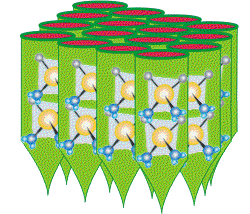Introduction
The functionalization of molecular systems, e.g. as optical or charge transfer induced spin state switches and sensor materials, depends critical on the assembly of the systems and a controlled surface morphology.
Also fundamental questions related to light-matter interactions and quantum optics can be addressed in self-organized assemblies of cavities or pores with nanoscale dimensions that are filled with correlated electron systems (e.g. molecular magnets), plasmonic metal wires or semiconducting quantum dots.
The interplay between size/structure and functionality leads to a rich spectrum of effects.
In our group we study all three systems using preparation and spectroscopic techniques. Essential parameters related to the control of spontaneous emission rates are the density of state, the quality factor of the cavity/pore and the volume of the constraints. Collaborations with respect to time resolved studies exist with the group of Samir Pal, Kolkata and are now extended to the functionalization of the emitter. Here we study the dynamic properties of molecular magnets within globular proteins.
Furthermore molecules in self organized nanotemplates can be used to investigate issues related to a contact of a nanosystem to the macroscopic world. Such an attempt is made in the recent work on porphyrine molecules attached to metallic wires.

Artistic view on a two-dimensional array of functionalized nanopores/cavities.
We use nanoporous Si (PS) and Al2O3 as template materials. These templates differ with respect to typical length scales (2-10nm vs. 10-200nm) and chemical functionality that can be manipulated. Different dyes (Rh6G, MCM and Malachite green) are individually anchored in the template to probe the pore/cavity wall functionality. Further experiments are related to the effect of molecule/pore interaction on coherence effects (see nanotemplates).
Local probe of correlations and spectroscopy: TERS
To probe such correlations a local probe can be used that is based on the proximity and local field enhancement of a nanoscopic metallic tip. This allows a topological resolution to address single cavities or pores on the surface. Similar effects without spacial resolution are achieved using gold wire arrays. For further details see TERS pages of the AG Lemmens.